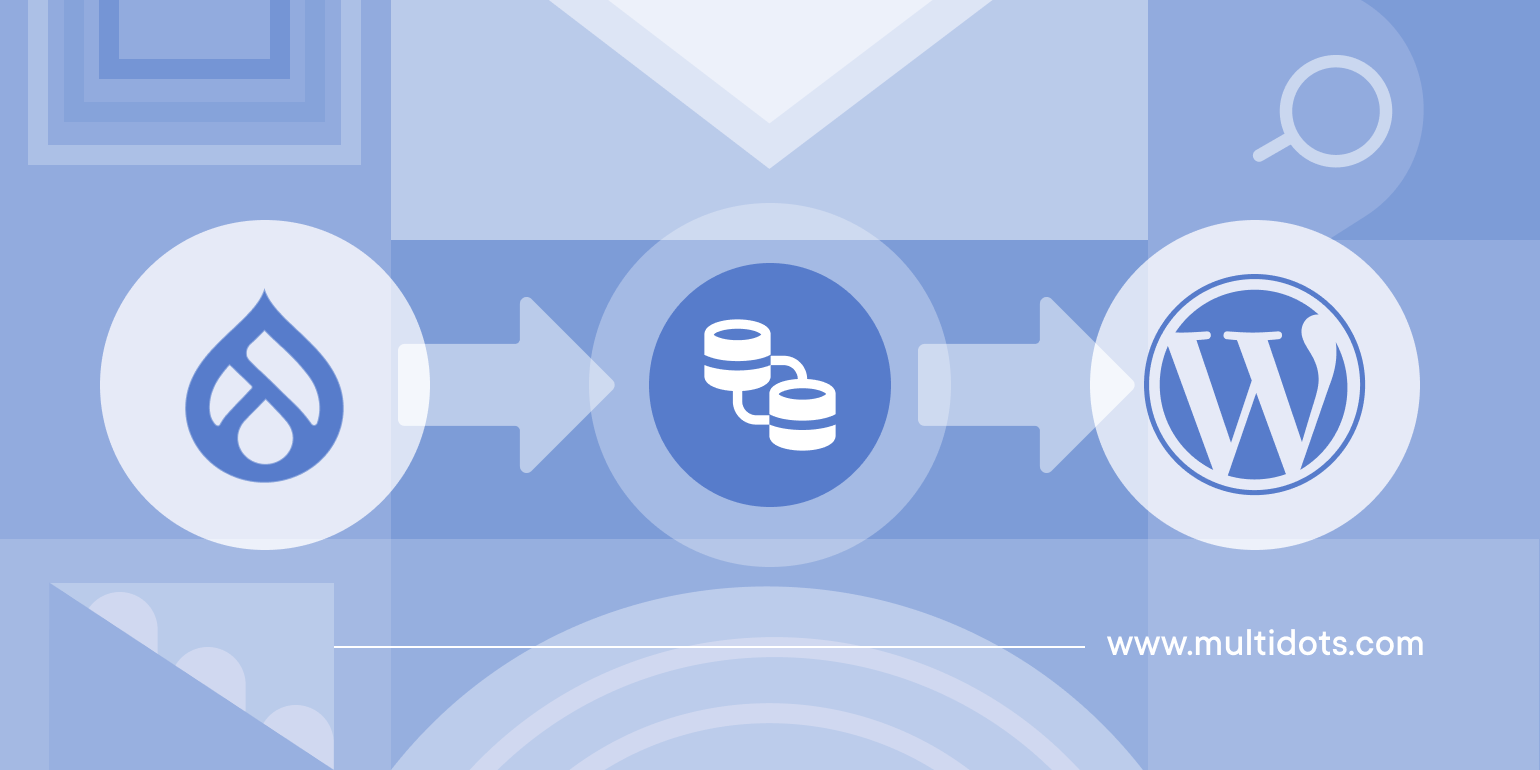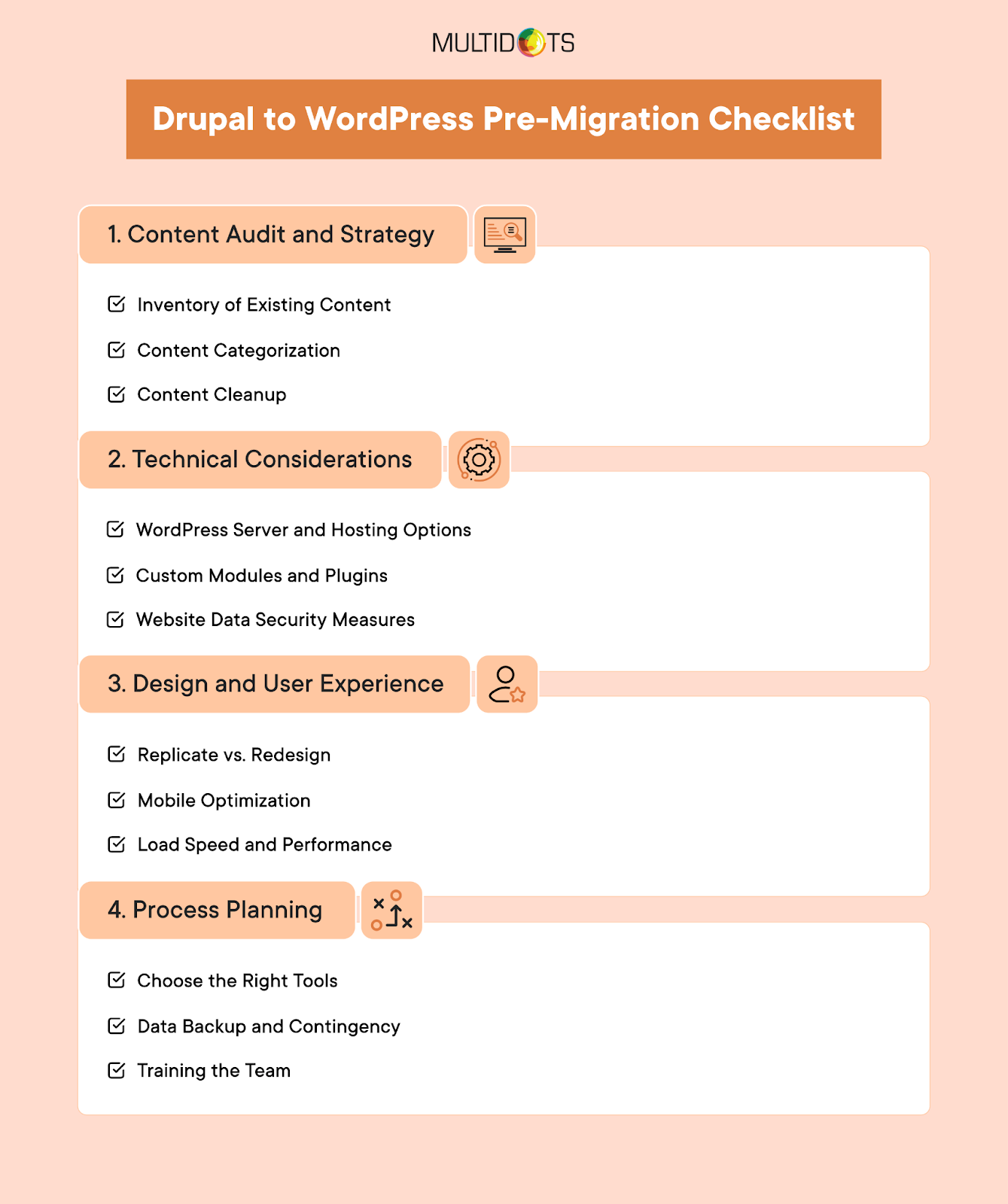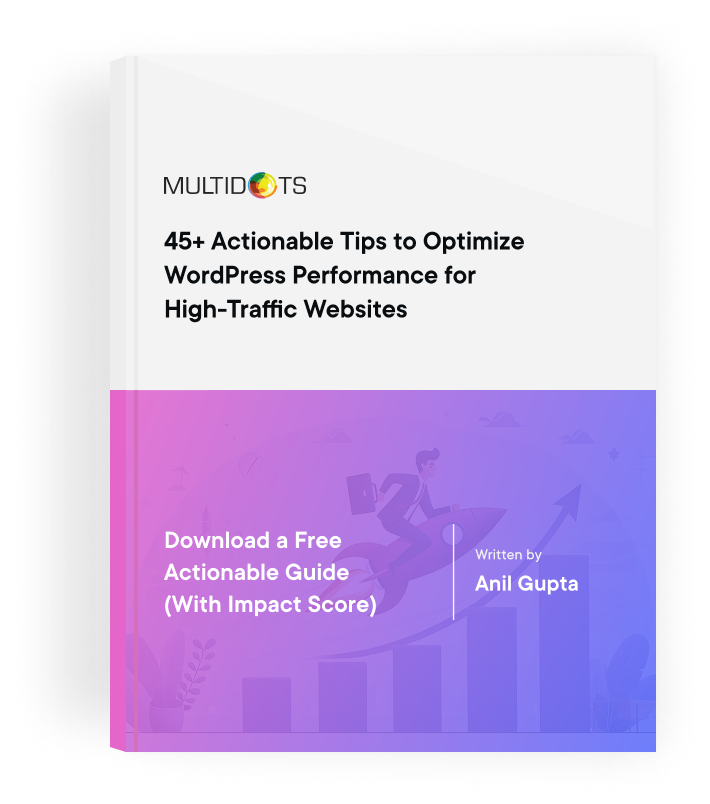How to Migrate from Drupal to WordPress Without Losing Data or SEO Rankings
Essential Pre-migration Checklist for Drupal to WordPress Migration in Enterprises

Table of Contents
WordPress offers various advantages to enterprises over Drupal. Better ease of use, scalability, and a huge global community are a few of them. This allows enterprises to manage content efficiently, train new team members quickly, and keep overhead costs low.
Before migrating from Drupal to WordPress, teams should make a detailed plan.
A well-thought migration strategy can help make the transition with minimal downtime while keeping all your data secure. Additionally, you can avoid unnecessary disruptions in your daily operations and overspending.
In this article, let’s look at the preparation you need to do before starting the Drupal to WordPress migration process for your enterprise website.
Here’s a checklist to keep everything handy:

1. Content audit and strategy
A content audit helps you decide what to keep, update, or discard from your current Drupal website. It is crucial for mapping the data migration strategy.
There are three components in this phase of Drupal to WordPress pre-migration:
Inventory of existing content: Create a comprehensive list of all content types to realize the scope of migration and spot essential elements.
- Export all content from Drupal
- Organize content by type and format
- Identify key metadata
Content categorization: Categories and tags improve navigation, maintain website structure, and enhance usability.
- Define key categories and tags
- Align existing content with WordPress taxonomy
- Plan new categories for future growth
Content cleanup: Delete the outdated and redundant content from your website. Apart from streamlining the migration process, it also preserves the SEO value.
- Identify and delete outdated content
- Update content that needs revision
- Ensure all media files are optimized
2. Technical considerations
Transitioning to WordPress requires you to consider various "under-the-hood" aspects related to servers, modules, and security. During the planning phase, focus on these areas:
WordPress server and hosting options: You can choose from many server and hosting options in the market, from dedicated to cloud, depending on your enterprise’s needs.
- Benchmark current traffic and server load
- Evaluate manage or self-hosted solutions
- Ensure hosting supports WordPress
Custom modules and plugins: Drupal’s modules may not have direct WordPress equivalents. Review tailored functionalities and find suitable alternatives.
- Mark all the custom Drupal modules and their role
- Discover and test the relevant WordPress plugins
- Map the new workflow to compare performance
- Consider custom plugins if needed
Website data security measures: Your sensitive information can be vulnerable during the migration process. It’s crucial to secure your new WordPress site completely before moving content.
- Set up SSL certificates
- Backup website data regularly
- Implement access control and security plugins
3. Design and user experience
A smooth user experience (UX) on an aesthetic website retains users for longer which increases conversion rates. WordPress, being quite flexible and versatile, gives you the opportunity to replicate your existing Drupal website design or create a new one.
Replicate vs Redesign: Copying what you have will be faster. However, you may not get many website redesigning opportunities like this.
- Select aspects that need to be tweaked or recreated entirely
- Review available free and premium themes
- Develop custom themes if needed (can drive up costs)
Mobile optimization: Your new WordPress enterprise website should be responsive across all devices and browsers to deliver a consistent UX.
- Ensure themes are mobile-responsive
- Test site functionality across different devices
- Optimize navigation for mobile users
Load speed and performance: Slow websites have lower rankings and high bounce rates as page speed is a Core Web Vital.
- Minimize CSS, JavaScript, and image sizes
- Implement caching solutions
- Test site speed at every stage of migration
4. Process planning
Now, you are ready to make the jump to WordPress. It is crucial to map out the entire migration process and visualize it for faster execution. This includes thinking of the tools and procedures that will determine the action items within the Drupal to WordPress migration process.
Choose the right tools: These solutions automate content transfer, URL redirection, etc., to reduce manual errors and oversights.
- Evaluate migration tools (e.g., FG Drupal to WordPress, WP All Import, etc.)
- Test tools on small data sets
- Write custom code and scripts as needed
Data backup and contingency: Create a full copy of your Drupal website and have a rollback plan in place as a safety net.
- Perform a complete Drupal site backup (files and database)
- Store backups in multiple secure locations
- Set up a rollback plan in case of migration failure
Training the team: Collect learning materials from various sources to build short courses that facilitate quicker adoption.
- Create a learning center to pool all the educational content
- Encourage internal team discussion
- Provide personalized assistance to employees as needed
Wrapping up: Choose an expert migration partner
As you can imagine by looking at the above pre-migration checklist, transitioning from Drupal to WordPress is a multilayered and complex process. Doing it in-house means you have to hire the right experts and build the necessary workflows, only to dissolve it after the task is completed.
Additionally, it increases the chances of mistakes and oversights, leading to data loss, security vulnerabilities, and higher downtime or disruptions. A better alternative is to partner with an expert Drupal to WordPress migration company for a hassle-free and cost-effective solution.
Multidots specializes in handling enterprise-grade migrations efficiently, helping teams move to WordPress from Drupal with minimal disruptions. Our team ensures that your content, site functionality, and SEO remain intact or get elevated after the migration.
On top of that, we provide continuous support to your team, to help you hit the ground running.
Ready to make the switch? Contact us today to get started.
FAQs
-
Common challenges include data loss, handling custom content types, mapping URL structures, and ensuring plugin compatibility. Without proper planning, issues like downtime, broken links, and disrupted functionality can also arise.
-
The migration timeline varies based on the website’s complexity and data volume. A small site may take a few days, while larger, content-heavy sites can take several weeks to complete.
-
Yes, custom Drupal modules can be migrated, but they may require custom development in WordPress using plugins or new custom code to replicate the functionality.
-
SEO rankings may be temporarily impacted, but proper redirects, SEO plugin usage, and maintaining the original URL structure can mitigate any long-term effects. A post-migration SEO audit is recommended.
-
Automation tools can handle a significant portion of the migration, such as content transfer, but manual intervention is often required for custom modules, design elements, and ensuring full functionality.
Feel free to schedule a quick call with our migration expert.
Contact Us
